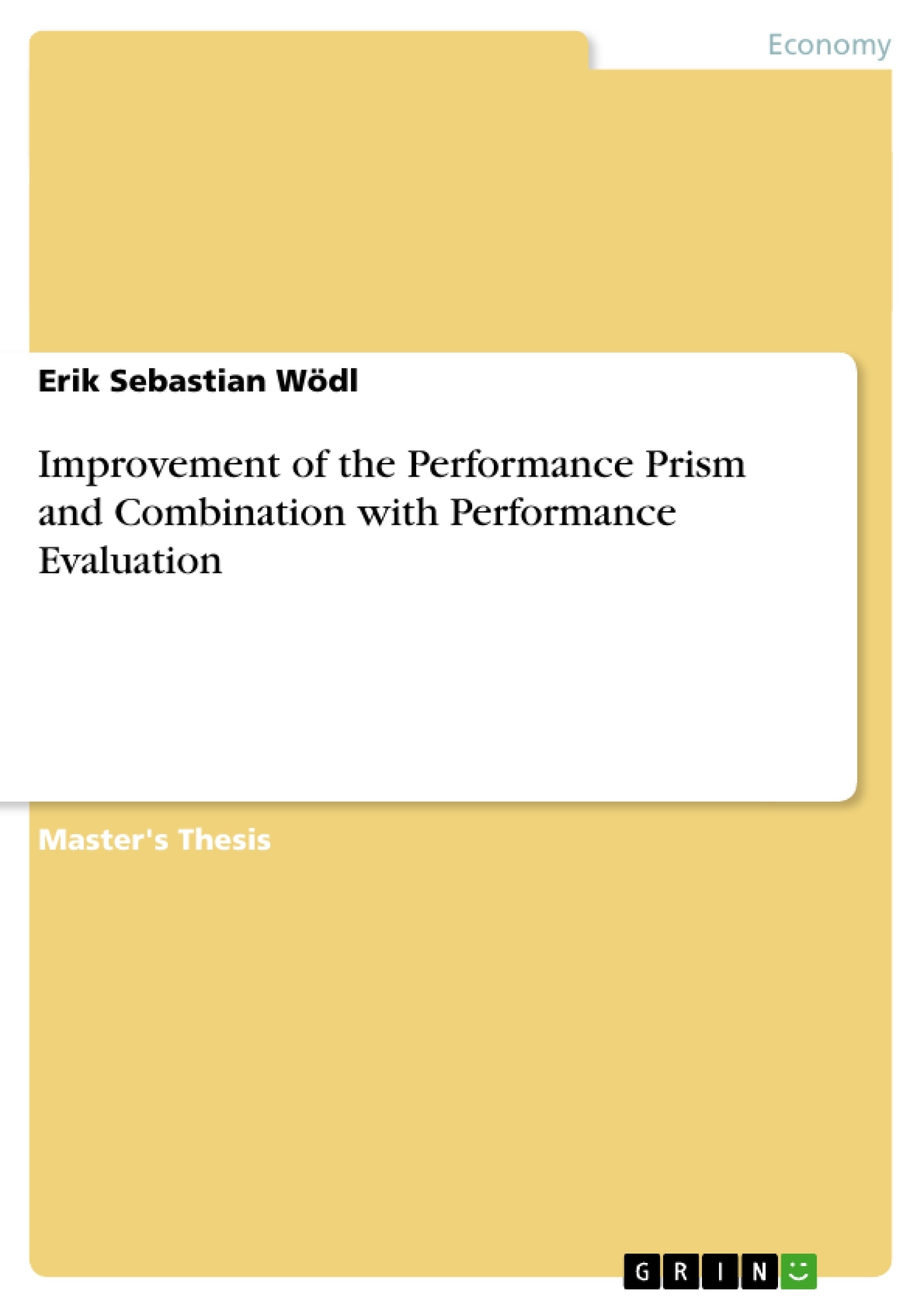After the glorious ascent of the Balanced Scorecard in the 80's, Neely, Adams and Kennerley developed in 2002 the Performance Prism as follower system of the Balanced Scorecard. The Performance Prism as a "second generation performance measurement system" claimed to adapt the advantages of the first generation systems but correct their shortcomings. The Performance Prism has the advantages of a multiple stakeholder recognition as well as a explicit strategy dimension. But Neely, Adams and Kennerley did not explain much how the Performance Prism can be applied to a single company department. This work tries to add value to the existing literature by the development of an departmental approach for the Performance Prism as well as an detailed way how to develop the departmental scorecard.
Table of Contents
- INTRODUCTION
- OUTCOME-VS. BEHAVIOR-BASED PERFORMANCE CONTROL
- COMBINED SYSTEMS
- PURPOSE OF THE THESIS
- METHODOLOGY OF THE WORK
- THE PRINCIPAL-AGENT APPROACH AS EXPLANATION FOR PERFORMANCE EVALUATION
- THE COMPANY AS THE PRINCIPLE
- THE SALESMAN AS THE AGENT
- SUMMARY OF THE CHAPTER
- INCENTIVE SYSTEMS AS A POTENTIAL SOLUTION TO THE CONTROL PROBLEM
- DEFINITIONS
- OUTCOME-BASED VERSUS BEHAVIOR-BASED CONTROL SYSTEMS
- EVALUATION OF THE CONTROL APPROACHES
- CRITERIA CATALOGUE
- SUMMARY OF THE CHAPTER
- THE BALANCED SCORECARD AS FIRST APPROACH
- PERSPECTIVES OF THE BALANCED SCORECARD
- EVALUATION OF THE BALANCED SCORECARD
- SUBOPTIMAL POINTS IN THE BALANCED SCORECARD
- SUMMARY OF THE CHAPTER
- NEELY'S PERFORMANCE PRISM
- PERSPECTIVES OF THE PERFORMANCE PRISM
- TOOLS AND ELEMENTS OF THE PERFORMANCE PRISM
- EVALUATION OF THE PERFORMANCE PRISM
- SUBOPTIMAL POINTS OF THE PERFORMANCE PRISM
- SUMMARY OF THE CHAPTER
- IMPROVEMENT OF THE PERFORMANCE PRISM
- COMBINATION OF THE STRATEGY VIEW BETWEEN THE BALANCED SCORECARD AND THE PERFORMANCE PRISM
- DESIGN OF AN DEPARTMENT PRISM SCORECARD APPROACH
- SUMMARY OF THE CHAPTER
- THEORETICAL IMPLEMENTATION OF THE STAKEHOLDER LEVEL DESIGN PHASE OF THE PERFORMANCE PRISM
- NEED FOR AN INTEGRATED DERIVATION APPROACH FOR THE PERFORMANCE PRISM
- DEVELOPMENT OF AN INTEGRATED AND DETAILED DEVELOPMENT METHOD FOR THE STAKEHOLDER LEVEL DESIGN PHASE
- SUMMARY OF THE CHAPTER
- IMPROVEMENT OF THE SIMPLE PERFORMANCE EVALUATION TOOL
- APPROACHES FOR PERFORMANCE EVALUATION
- SUMMARY OF THE CHAPTER
- SYNTHESIS OF THE MULTIDIMENSIONAL APPROACH WITH THE PERFORMANCE PRISM
- STEPS OF THE COMBINATION OF PERFORMANCE EVALUATION WITH THE PERFORMANCE PRISM
- SUMMARY OF THE CHAPTER
- SUMMARY
- CRITICAL REVIEW OF THE THESIS
- VALUE ADD OF THE PREVIOUS WORK
- Issues NOT ANSWERED YET
- SOURCES
Objectives and Key Themes
This thesis aims to improve the Neely Performance Prism and combine it with performance evaluation. It analyzes the challenges of aligning individual performance with organizational goals, particularly in a context where outcome-based performance evaluation systems are prevalent. The work explores the strengths and limitations of various performance measurement approaches, including the Balanced Scorecard and the Performance Prism.
- The limitations of traditional outcome-based performance evaluation systems
- The benefits and drawbacks of behavior-based performance control
- The use of the Performance Prism and Balanced Scorecard in aligning individual performance with organizational strategy
- Development of a comprehensive approach that combines the Performance Prism with a multidimensional performance evaluation system
- The practical implementation of the integrated approach in a real-world business setting.
Chapter Summaries
The thesis begins by exploring the principal-agent problem, emphasizing the challenges of aligning the goals of the company (the principal) with the goals of its employees (the agents). It examines the need for incentive systems to motivate employees and align individual goals with organizational goals.
The work then analyzes the limitations of traditional outcome-based performance evaluation systems, outlining the benefits of incorporating behavior-based approaches. It explores various performance measurement models like the Balanced Scorecard, highlighting their strengths and limitations. The thesis focuses on the Neely Performance Prism, presenting its theoretical framework, perspectives, and key elements.
A significant part of the thesis is dedicated to improving the Performance Prism. The author proposes a new approach that integrates the strategy view of the Balanced Scorecard with the Performance Prism. This approach aims to provide a more comprehensive and holistic understanding of performance measurement within an organization.
The thesis concludes by outlining the practical steps involved in combining the multidimensional performance evaluation approach with the Performance Prism. It discusses the key elements of the combined approach and provides a detailed theoretical framework for its implementation.
Keywords
The primary keywords and focus topics of this thesis are: performance measurement, performance evaluation, performance prism, Balanced Scorecard, principal-agent problem, incentive systems, stakeholder analysis, strategy alignment, multidimensional performance evaluation, employee motivation, organizational goals.
- Quote paper
- Erik Sebastian Wödl (Author), 2013, Improvement of the Performance Prism and Combination with Performance Evaluation, Munich, GRIN Verlag, https://www.grin.com/document/212600




